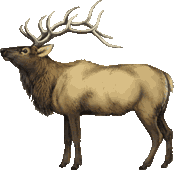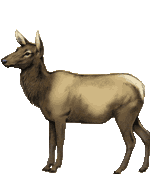|
 
Family Cervidae
Cervus elaphus
Description: Brown to yellowish brown body; darker brown on head, neck, and legs; yellowish to orangish rump patch;
hair on neck and mane much longer in bulls than in cows. Bulls, 4 to 5 feet high at the shoulder; 600 to 1,000
pounds; antlers from 12-inch single spike to seven-point antlers 48 inches high. Cows, 500 to 600 pounds; no antlers.
Similar species: Mule deer-smaller, black on tip of tail.
Habitat/Distribution: Found in coniferous forests with grassy clearings (meadows, grasslands, burns, and logged
areas) through-out the region and in RMNP. Intolerant of human disturbance and over hunting.
Food: Grasses, sedges, forbs, shrubs (willow, serviceberry, snow-brush, sagebrush, etc.), and trees (chokecherry,
maple, fir).
Elk usually feed actively from the predawn darkness to about midmorning, when they rest and chew their cud. They
may feed sporadically during the day but often do not move much until midafternoon, when they begin feeding again.
They often bed high on mountain slopes, where they have a good view of the surrounding area and rising thermals
bring the scent of other forest inhabitants from below. In bad weather, they seek more sheltered sites for protection
from the elements.
Elk are gregarious and remain in herds throughout the year. Summer herds, consisting of cows, calves, and young
(spike) bulls-usually led by an old cow-are often found above timberline or in grassy clearings just below timberline.
Mature bulls spend the summer off by themselves in groups of up to three or four.
The normally calm summer routine of feeding and resting throughout the day is suddenly disrupted in September when
the rut begins. Bulls begin thrashing bushes and small trees in late August and early September to relieve tensions
caused by increasing levels of testosterone. They begin bugling to broadcast their presence to other bulls, and
the larger bulls join one of the cow herds and assume the responsibility of keeping other bulls away. When a cow
comes into heat, the bull stays close to her until she is bred and then leaves to attend another cow that is in
heat. Cows are capable of breeding at two and a half years.
|